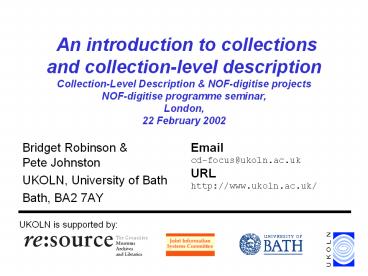An introduction to collections and collection-level description Collection-Level Description - PowerPoint PPT Presentation
Title:
An introduction to collections and collection-level description Collection-Level Description
Description:
Unitary. info about collection as whole, not about items. Hierarchic ... unitary. RSLP CD schema provides basis for unitary descriptions. Collection-level description ... – PowerPoint PPT presentation
Number of Views:30
Avg rating:3.0/5.0
Title: An introduction to collections and collection-level description Collection-Level Description
1
An introduction to collectionsand
collection-level descriptionCollection-Level
Description NOF-digitise projectsNOF-digitise
programme seminar,London, 22 February 2002
- Bridget Robinson Pete Johnston
- UKOLN, University of Bath
- Bath, BA2 7AY
Email cd-focus_at_ukoln.ac.uk URL http//www.ukoln.ac
.uk/
UKOLN is supported by
2
An introduction to collections and
collection-level description
- Collection Description Focus
- What is a collection?
- Collection description collection-level
description - Collection-level descriptions as metadata records
- Why collection-level description?
3
Collection Description Focus
4
Collection Description Focus
- Funded by
- Research Support Libraries Programme (RSLP)
- JISC Distributed National Electronic Resource
(DNER) - British Library
- Improve consistency, compatibility of approaches
to collection-level description
5
Collection Description Focus (2)
- Proposal supported by
- Archives Hub
- mda
- Based at UKOLN
- experience of RSLP Collection Description
- Benefit from collaboration with
- Interoperability Focus
- DNER Architecture team
- CIMI (museums)
- Dublin Core Collection Description WG
6
Collection Description Focus (3)
- Gather information on existing practice
- survey questionnaire, implementer visits
- Point of contact, advice
- Consensus-building
- CD Forum
- Disseminate good practice
- workshops, briefing days
- publications
- recommendations, guidelines
- support for CLD in other programmes
7
What is a collection?
8
What is a collection?
- Collection
- an aggregation of physical and/or digital items
- Aggregates of, e.g.
- natural objects fossils, mineral samples
- created objects artefacts, documents, records
- digital resources documents, images, multimedia
objects, data, software - digital surrogates of physical objects
documents, images - metadata catalogue records, item descriptions,
collection-level descriptions (!)
9
What is a collection? (2)
- Various criteria for aggregation, e.g.
- By location
- By type/form of item
- By provenance of item
- By source/ownership of item
- By nature of item content
- .
- Permanent, temporary
- Discrete, distributed
10
Collection description collection-level
description
11
Collection description collection-level
description
- Collection description
- Michael Heaneys analytic model
- Unitary
- info about collection as whole, not about items
- Hierarchic
- info about collection as whole, and about items
(and relationships between items and whole) - Analytic
- info about items in collection
- Indexing
- info derived from items in collection
12
Collection description collection-level
description
- Collection-level description
- unitary
- RSLP CD schema provides basis for unitary
descriptions - Collection-level description
- what is level of aggregation is
collection-level in this context? - functional granularity
13
CLDs as metadata
14
CLDs as metadata
- Metadata
- Machine understandable information about web
resources or other things.(Berners-Lee, 1997) - Structured data about resources that can be used
to help support a wide range of operations - A collection is a type of resource
- CLDs are metadata records
- Used by
- human agents (owner, researcher, 3rd party)
- software agents (e.g. aggregators, portals,
brokers)
15
Item level metadata records
Creator
Date
Title
Item
Item 1
M Jagger
2001-11-05
Report
1
Item 2
Metadata database
16
Collection-level metadata records
Collection 1
Creator
Date
Title
Coll
T Moore
2002-01-01
His Collection
1
K Gordon
2001-12-25
Her Collection
2
Metadata database
17
What operations?
Owner / manager / provider establish control of resources administer/manage (through time) disclose/promote enable and control access/use contextualise
End user find, identify, select obtain/use interpret
Third party service disclose/promote enable and control access/use annotate re-contextualise
18
Metadata for resource discovery
- Resource users may wish to
- search across descriptions from different
providers - compare/combine descriptions from different
providers - Resource providers may wish to
- disseminate descriptions widely
- share descriptions with other providers, 3rd
parties - describe relationships between resources
- Third parties may wish to
- build services on descriptions prepared by
others - annotate descriptions prepared by others
19
Metadata for resource discovery
- Metadata for resource discovery
- is used beyond its creator community
- is combined with metadata from other communities
- is aggregated or cross-searched
- challenge of semantic interoperability
- CLD as an overview of aggregate of items
- useful in many different contexts, for many
purposes
20
Why collection-level description?
21
Why collection-level description?
- Collection-level description might
- Disclose information about collections
- Provide overview of otherwise uncatalogued items
- Enable user to select collections to search on
basis of summary description - Enable software agents to select collections to
search on behalf of user - Support controlled searching of multiple
collections
22
Why collection-level description? (2)
- Cross-domain
- (Slightly) different ideas of collections
- Different ways of talking about collections
- Different criteria for defining collections
- Different ways of describing collections
- But useful/possible to agree on broadly common
view? - Permit user to compare broadly similar high-level
objects - even where items heterogeneous
23
Acknowledgements
- UKOLN is funded by Resource the Council for
Museums, Archives and Libraries, the Joint
Information Systems Committee (JISC) of the UK
higher and further education funding councils, as
well as by project funding from the JISC and the
European Union. UKOLN also receives support from
the University of Bath where it is based. - http//www.ukoln.ac.uk/































